Related Research Articles

Lizard is the common name used for all squamate reptiles other than snakes, encompassing over 7,000 species, ranging across all continents except Antarctica, as well as most oceanic island chains. The grouping is paraphyletic as some lizards are more closely related to snakes than they are to other lizards. Lizards range in size from chameleons and geckos a few centimeters long to the 3-meter-long Komodo dragon.

In zoology, a scale is a small rigid plate that grows out of an animal's skin to provide protection. In lepidopterans, scales are plates on the surface of the insect wing, and provide coloration. Scales are quite common and have evolved multiple times through convergent evolution, with varying structure and function.

The Lepidosauria is a subclass or superorder of reptiles, containing the orders Squamata and Rhynchocephalia. Squamata also includes lizards and snakes. Squamata contains over 9,000 species, making it by far the most species-rich and diverse order of non-avian reptiles in the present day. Rhynchocephalia was a formerly widespread and diverse group of reptiles in the Mesozoic Era. However, it is represented by only one living species: the tuatara, a superficially lizard-like reptile native to New Zealand.
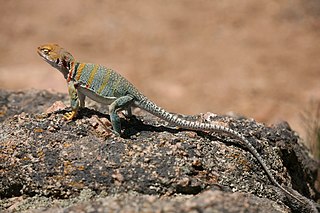
The Crotaphytidae, or collared lizards, are a family of desert-dwelling reptiles native to the Southwestern United States and northern Mexico. Alternatively they are recognized as a subfamily, Crotaphytinae, within the clade Pleurodonta. They are very fast-moving animals, with long limbs and tails; some species are capable of achieving bipedal running at top speed. This species is carnivorous, feeding mainly on insects and smaller lizards. The two genera contain 12 species.

The Acrochordidae, commonly known as wart snakes, Java wart snakes, file snakes, elephant trunk snakes, or dogface snakes are a monogeneric family created for the genus Acrochordus. This is a group of basal aquatic snakes found in Australia and tropical Asia. Currently, three species are recognized.

Keeled scales refer to reptile scales that, rather than being smooth, have a ridge down the center that may or may not extend to the tip of the scale, making them rough to the touch. According to Street's (1979) description of European lizards and snakes, in those that have keeled scales the keels are usually stronger in male specimens and are consistently arranged according to the species of reptiles, even though many others do not have them. With European lizards, the dorsal scales are usually well keeled, while those on the flanks are more weakly keeled and those on the belly smooth. Non-European lizards such as Sphaerodactylus macrolepis also display keeled scales.
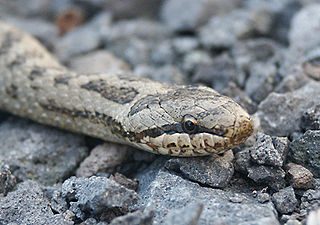
The smooth snake is a species of non-venomous snake in the family Colubridae. The species is found in northern and central Europe, but also as far east as northern Iran. The Reptile Database recognizes two subspecies as being valid, including the nominotypical subspecies described here.

The tiger snake is a large and highly venomous snake of southern Australia, including its coastal islands and Tasmania. These snakes are often observed and locally well known by their banding, black and yellow like a tiger, although the species can be highly variable in colouration and patterning. All populations are classified within the genus Notechis (Elapidae). Their diverse characteristics have been classified either as distinct species or by subspecies and regional variation.

The timber rattlesnake, canebrake rattlesnake, or banded rattlesnake is a species of pit viper endemic to eastern North America. Like all other pit vipers, it is venomous, with a very toxic bite. C. horridus is the only rattlesnake species in most of the populous Northeastern United States and is second only to its relatives to the west, the prairie rattlesnake, as the most northerly distributed venomous snake in North America. No subspecies are currently recognized.

Indotyphlops braminus, commonly known as the brahminy blind snake and other names, is a non-venomous blind snake species, found mostly in Africa and Asia, and has been introduced in many other parts of the world. It is a completely fossorial reptile, with habits and appearance similar to an earthworm, for which it is often mistaken, although close examination reveals tiny scales and eyes rather than the annular segments characteristic of a true earthworm. The species is parthenogenetic and all known specimens have been female. The specific name is a Latinized form of the word Brahmin. No subspecies are currently recognized as being valid.

Snakes, like other reptiles, have skin covered in scales. Snakes are entirely covered with scales or scutes of various shapes and sizes, known as snakeskin as a whole. A scale protects the body of the snake, aids it in locomotion, allows moisture to be retained within, alters the surface characteristics such as roughness to aid in camouflage, and in some cases even aids in prey capture. The simple or complex colouration patterns are a property of the underlying skin, but the folded nature of scaled skin allows bright skin to be concealed between scales then revealed in order to startle predators.
In scaled reptiles, the ocular scales are those forming the margin of the eye. The name originates from the term oculus which is Latin for 'eye' and, in the broadest sense, refers to a scale associated with the eye. The numbers of these scales present, and sometimes the shapes and sizes, are some of many characteristics used to differentiate species from one another.
In reptiles, the supralabial scales, also called upper-labials, are those scales that border the mouth opening along the upper jaw. They do not include the median scale. The term labial originates from Labium, which refers to any lip-like structure. The numbers of these scales present, and sometimes the shapes and sizes, are some of many characteristics used to differentiate species from one another.
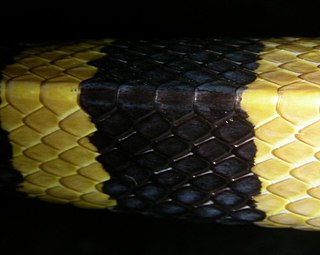
In snakes, the dorsal scales are the longitudinal series of plates that encircle the body, but do not include the ventral scales.
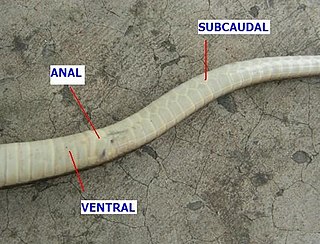
In snakes, the ventral scales or gastrosteges are the enlarged and transversely elongated scales that extend down the underside of the body from the neck to the anal scale. When counting them, the first is the anteriormost ventral scale that contacts the paraventral (lowermost) row of dorsal scales on either side. The anal scale is not counted.

Reptile skin is covered with scutes or scales which, along with many other characteristics, distinguish reptiles from animals of other classes. They are made of alpha and beta-keratin and are formed from the epidermis. The scales may be ossified or tubercular, as in the case of lizards, or modified elaborately, as in the case of snakes.
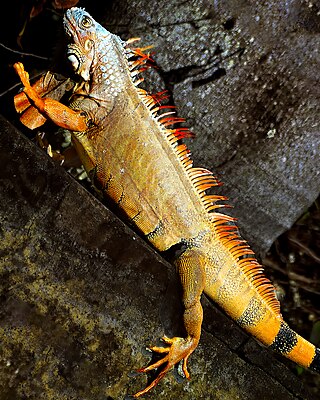
Iguana is a genus of herbivorous lizards that are native to tropical areas of Mexico, Central America, South America, and the Caribbean. The genus was first described by Austrian naturalist J.N. Laurenti in 1768. Two species are placed in the genus: The green iguana, which is widespread throughout its range and a popular pet; and the Lesser Antillean iguana, which is native to the Lesser Antilles. Genetic analysis indicates that the green iguana may comprise a complex of multiple species, some of which have been recently described, but the Reptile Database considers all of these as subspecies of the green iguana.
Hammerhead is a Minneapolis-based noise rock band active in the early 1990s. Members went on to form the band Vaz.
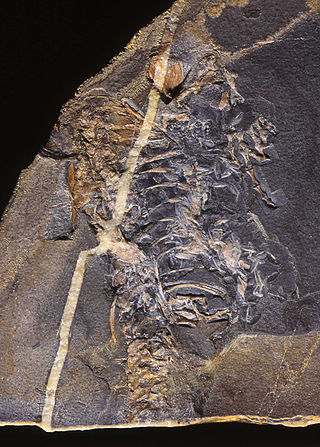
Reptiles arose about 320 million years ago during the Carboniferous period. Reptiles, in the traditional sense of the term, are defined as animals that have scales or scutes, lay land-based hard-shelled eggs, and possess ectothermic metabolisms. So defined, the group is paraphyletic, excluding endothermic animals like birds that are descended from early traditionally-defined reptiles. A definition in accordance with phylogenetic nomenclature, which rejects paraphyletic groups, includes birds while excluding mammals and their synapsid ancestors. So defined, Reptilia is identical to Sauropsida.

The lore is the region between the eyes and nostrils of birds, reptiles, and amphibians.
References
- ↑ Schleich HH, Kästle W, Kabisch K (1996). Amphibians and Reptiles of North Africa: Biology, Systematics, Field Guide. Koenigstein, Germany: Koeltz Scientific Books. 630 pp., 63 color plates. ISBN 978-3-87429-377-8.